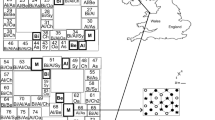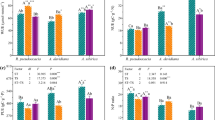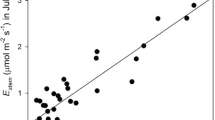Abstract
Mixed plantations might contribute to sustainable land use because of complementary nutrient use. Our objective was to assess the nutrient economy of five native tree species and their response to different neighbor trees in an experimental plantation in Panama. In our study, H. crepitans was the least nutrient efficient tree species. H. crepitans produced less biomass in mixtures than in monocultures while Cedrela odorata – the most nutrient efficient species – produced more biomass independent of stem growth rates because they acquired more nutrients in mixtures than in monocultures.Three-species mixtures had increased mean Ca concentrations in branches and stems and increased N, P, K, Ca, and Mg storage in aboveground biomass compared to monocultures suggesting complementary resource uptake. Our results highlight the need to properly consider species-specific nutrient requirements and species interactions when designing tree mixtures for afforestation.



Similar content being viewed by others
Abbreviations
- A. exc. :
-
Anacardium excelsum (Bert. & Balb. Ex Kunth) Skeels
- BA:
-
basal area
- BM:
-
biomass
- C. odo. :
-
Cedrela odorata L.
- DBH:
-
diameter at breast height
- DMAX :
-
deviation from expected biomass production or nutrient storage based on best performance of corresponding monocultures
- H. cre. :
-
Hura crepitans L.
- HT:
-
height
- L. see. :
-
Luehea seemannii Triana & Planch
- NF:
-
neighborhood factor
- NW:
-
neighborhood weighted
- T. ros. :
-
Tabebuia rosea (Bertol.) DC
References
Binkley D, Senock R, Bird S, Cole TG (2003) Twenty years of stand development in pure and mixed stands of Eucalyptus saligna and nitrogen-fixing Facaltaria moluccana. For Ecol Manage 182:93–102
Breiman L, Spector P (1992) Submodel selection and evaluation in regression: the X-random case. Int Stat Rev 60:291–319. doi:10.2307/1403680
Brown S, Gillespie AJR, Lugo AE (1989) Biomass estimation methods for tropical forests with applications to forest inventory data. For Sci 35:881–902
Bunker DE, DeClerck F, Bradford JC, Colwell RK, Perfecto I, Phillips OL, Sankaran M, Naeem S (2005) Species loss and aboveground carbon storage in a tropical forest. Science 310:1029–1031. doi:10.1126/science.1117682
Caldeira MC, Hector A, Loreau M, Pereira JS (2005) Species richness, temporal variability and resistance of biomass production in a Mediterranean grassland. Oikos 110:115–123. doi:10.1111/j.0030-1299.2005.13873.x
Chave J, Andalo C, Brown S, Cairns MA, Chambers JQ, Eamus D, Fölster H, Fromard F, Higuchi N, Kira T, Lescure JP, Puig H, Riéra B, Yamakura T (2005) Tree allometry and improved estimation of carbon stocks and balance in tropical forests. Oecologia 145:87–99. doi:10.1007/s00442-005-0100-x
Coll L, Potvin C, Messier C, Delagrange S (2008) Root architecture and allocation patterns of eight native tropical species with different successional status used in open-grown mixed plantations in Panama. Trees - Structure and Function 22:585–596
Cuevas E, Medina E (1986) Nutrient dynamics within Amazonian forest ecosystems. I. Nutrient flux in fine litter fall and efficiency of nutrient utilization. Oecologia 68:466–472
Elberling B, Matthiesen H (2007) Methodologically controlled variations in laboratory and field pH measurements in waterlogged soils. Eur J Soil Sci 58:207–214. doi:10.1111/j.1365-2389.2006.00828.x
Evans J, Turnbull JW (2004) Plantation forestry in the Tropics, 3rd edn. Oxford University Press, Oxford, p 467
FAO (1998) World reference base for soil resources. World soil resources reports, Rome
Fowomola MA, Akindahunsi AA (2007) Nutritional quality of sandbox tree (Hura crepitans Linn.). J Med Food 10:159–164. doi:10.1089/jmf.2005.062
Fridley JD (2003) Diversity effects on production in different light and fertility environments: an experiment with communities of annual plants. J Ecol 91:396–406. doi:10.1046/j.1365-2745.2003.00775.x
Fujinuma R, Bockheim J, Balster N (2005) Base-cation cycling by individual tree species in old-growth forests of Upper Michigan, USA. Biogeochemistry 74:357–376. doi:10.1007/s10533-004-4726-2
Groffman PM, Driscoll CT, Likens GE, Fahey TJ, Holmes RT, Eagar C, Aber JD (2004) Nor gloom of night: a new conceptual model for the Hubbard Brook ecosystem study. Bioscience 54:139–148. doi:10.1641/0006-3568(2004) 054[0139:NGONAN]2.0.CO;2
Hagen-Thorn A, Armolaitis S, Callesen I, Stjernquist I (2004) Macronutrients in tree stems and foliage: a comparative study of six temperate forest species planted at the same sites. Ann For Sci 61:489–498. doi:10.1051/forest:2004043
Harper J (1977) Population biology of plants. Academic, New York
Healy C, Gotelli NJ, Potvin C (2008) Partitioning the effects of biodiversity and environmental heterogeneity for productivity and mortality in a tropical tree plantation. J Ecol 96:903–913. doi:10.1111/j.1365-2745.2008.01419.x
Hector A, Bazeley-White E, Loreau M, Otway S, Schmid B (2002) Overyielding in grassland communities: testing the sampling effect hypothesis with replicated biodiversity experiments. Ecol Lett 5:502–511. doi:10.1046/j.1461-0248.2002.00337.x
Hector A, Schmid B, Beierkuhnlein C, Caldeira MC, Diemer M, Dimitrakopoulos PG, Finn JA, Freitas H, Giller PS, Good J, Harris R, Hogberg P, Huss-Danell K, Joshi J, Jumpponen A, Körner C, Leadley PW, Loreau M, Minns A, Mulder CPH, O'Donovan G, Otway SJ, Pereira JS, Prinz A, Read DJ, Scherer-Lorenzen M, Schulze ED, Siamantziouras ASD, Spehn EM, Terry AC, Troumbis AY, Woodward FI, Yachi S, Lawton JH (1999) Plant diversity and productivity experiments in European grasslands. Science 286:1123–1127. doi:10.1126/science.286.5442.1123
Hiremath AJ, Ewel JJ (2001) Ecosystem nutrient use efficiency, productivity, and nutrient accrual in model tropical communities. Ecosystems (N Y, Print) 4:669–682. doi:10.1007/s10021-001-0036-x
Hiremath AJ, Ewel JJ, Cole TG (2002) Nutrient use efficiency in three fast-growing tropical trees. For Sci 48:662–672
Hooper DU, Chapin FS, Ewel JJ, Hector A, Inchausti P, Lavorel S, Lawton JH, Lodge DM, Loreau M, Naeem S, Schmid B, Setala H, Symstad AJ, Vandermeer J, Wardle DA (2005) Effects of biodiversity on ecosystem functioning: a consensus of current knowledge. Ecol Monogr 75:3–35. doi:10.1890/04-0922
Ingestad T, Ågren GI (1992) Theories and methods on plant nutrition and growth. Physiol Plant 84:177–184. doi:10.1111/j.1399-3054.1992.tb08781.x
Leopold AC, Andrus R, Finkeldey A, Knowles D (2001) Attempting restoration of wet tropical forests in Costa Rica. For Ecol Manage 142:243–249
Kelty MJ (2006) The role of species mixtures in plantation forestry. For Ecol Manage 233:195–204
Kennedy TA, Naeem S, Howe KM, Knops JMA, Tilman D, Reich P (2002) Biodiversity as a barrier to ecological invasion. Nature 411:636–638. doi:10.1038/nature00776
Ketterings QM, Coe R, van Noordwijk M, Ambagau Y, Palm CA (2001) Reducing uncertainty in the use of allometric biomass equations for predicting above-ground tree biomass in mixed secondary forests. For Ecol and Manage 146:199–209
Kuo S (1996) Phosphorus. In: Sparks DL, Page AL, Helmke PA, Loeppert RH, Soltanpour PN, Tabatabai MA, Johnston CT, Sumner ME (eds) Methods of soil analysis - part 3: chemical methods. SSSA, Madison, pp 869–920
Mackensen J, Tillery-Stevens M, Klinge R, Folster H (2000) Site parameters, species composition, phytomass structure and element stores of a terra-firme forest in East-Amazonia, Brazil. Plant Ecol 151:101–119. doi:10.1023/A:1026515116944
Montagnini F (2000) Accumulation in above-ground biomass and soil storage of mineral nutrients in pure and mixed plantations in a humid tropical lowland. For Ecol Manage 134:257–270
Naeem S, Hakansson K, Lawton JH, Crawley MJ, Thompson LJ (1996) Biodiversity and plant productivity in a model assemblage of plant species. Oikos 76:259–264. doi:10.2307/3546198
Overman MPJ, Witte LJH, Saldarriaga GJ (1994) Evaluation of regression models for above ground biomass determination in Amazon rainforest. J Trop Ecol 10:207–218
Palmborg C, Scherer-Lorenzen M, Jumpponen A, Carlsson G, Huss-Danell K, Hogberg P (2005) Inorganic soil nitrogen under grassland plant communities of different species composition and diversity. Oikos 110:271–282. doi:10.1111/j.0030-1299.2005.13673.x
Parrotta JA (1999) Productivity, nutrient cycling, and succession in single- and mixed-species plantations of Casuarina equisetifolia, Eucalyptus robusta, and Leucaena leucocephala in Puerto Rico. For Ecol Manage 124:45–77
Parton WJ, Scurlock DS, Ojima DS (1993) Observations and modeling of biomass and organic-matter dynamics for the grassland biome worldwide. Global Biogeochem Cycles 7:785–809. doi:10.1029/93GB02042
Piotto D (2008) A meta-analysis comparing tree growth in monocultures and mixed plantations. For Ecol Manage 255:781–786
Potvin C, Gotelli NJ (2008) Biodiversity enhances individual performance but does not affect survivorship in tropical trees. Ecol Lett 11:217–223. doi:10.1111/j.1461-0248.2007.01148.x
Potvin C, Whidden E, Moore T (2004) A case study of carbon pools under three different land-uses in Panama. Clim Change 67:291–307. doi:10.1007/s10584-004-0079-z
Pretzsch H (2005) Diversity and productivity in forests: evidence from long-term experimental plots. In: Scherer-Lorenzen M, Körner C, Schulze E-D (eds) Forest diversity and function: temperate and boreal systems, Ecological Studies, 176. Springer, Berlin, pp 41–64
Raich JW, Rastetter EB, Melillo JM, Kicklighter DW, Steudler PA, Peterson BJ, Grace AL, Moore BI, Vorosmarty CJ (1991) Potential net primary productivity in South-America - application of a global model. Ecol Appl 1:399–429. doi:10.2307/1941899
Redondo-Brenes A, Montagnini F (2006) Growth, productivity, aboveground biomass, and carbon sequestration of pure and mixed native tree plantations in the Caribbean lowlands of Costa Rica. For Ecol Manage 232:168–178
Reimann C, Arnoldussen A, Boyd R, Finne TE, Koller F, Nordgulen O, Englmaier P (2007) Element contents in leaves of four plant species (birch, mountain ash, fern and spruce) along anthropogenic and geogenic concentration gradients. Sci Total Environ 377:416–433. doi:10.1016/j.scitotenv.2007.02.011
Rincon J, Martinez F (2006) Food quality and feeding preferences of Phylloicus sp (Trichoptera : Calamoceratidae). JN Am Benthol Soc 25:209–215. doi:10.1899/0887-3593(2006)25[209:FQAFPO]2.0.CO;2
Rothe A, Binkley D (2001) Nutritional interactions in mixed species forests: a synthesis. Can J For Res 31:1855–1870. doi:10.1139/cjfr-31-11-1855
Running SW, Coughlan JC (1988) General model of forest ecosystem processes for regional applications. 1. Hydrologic balance, canopy gas exchange and primary production processes. Ecol Modell 42:125–154. doi:10.1016/0304-3800(88)90112-3
Scherer-Lorenzen M, Bonilla JL, Potvin C (2007a) Tree species richness affects litter production and decomposition rates in a tropical biodiversity experiment. Oikos 116:2108–2124. doi:10.1111/j.2007.0030-1299.16065.x
Scherer-Lorenzen M, Schulze E-D, Don A, Schumacher J, Weller E (2007b) Exploring the functional significance of forest diversity: a new long-term experiment with temperate tree species (BIOTREE). Perspect Plant Ecol Evol Syst 9:53–70. doi:10.1016/j.ppees.2007.08.002
Smith K, Gholz HL, Oliveira FdA (1998) Litterfall and nitrogen-use efficiency of plantations and primary forests in the eastern Brazilian Amazon. For Ecol Manage 209:209–220
Spehn EM, Hector A, Joshi J, Scherer-Lorenzen M, Schmid B, Bazeley-White E, Beierkuhnlein C, Caldeira MC, Diemer M, Dimitrakopoulos PG, Finn JA, Freitas H, Giller PS, Good J, Harris R, Hogberg P, Huss-Danell K, Jumpponen A, Koricheva J, Leadley PW, Loreau M, Minns A, Mulder CPH, O'Donovan G, Otway SJ, Palmborg C, Pereira JS, Pfisterer AB, Prinz A, Read DJ, Schulze ED, Siamantziouras ASD, Terry AC, Troumbis AY, Woodward FI, Yachi S, Lawton JH (2005) Ecosystem effects of biodiversity manipulations in European grasslands. Ecol Monogr 75:37–63. doi:10.1890/03-4101
Sumner ME, Miller WP (1996) Cation exchange capacity and exchange coefficients. In: Sparks DL, Page AL, Helmke PA, Loeppert RH, Soltanpour PN, Tabatabai MA, Johnston CT, Sumner ME (eds) Methods of soil analysis - part 3 chemical methods. SSSA, Madison, Wisconsin, pp 1201–1229
Tilman D, Wedin D, Knops J (1996) Productivity and sustainability influenced by biodiversity in grassland ecosystems. Nature 379:718–720. doi:10.1038/379718a0
Tilman D, Reich PB, Knops J, Wedin D, Mielke T, Lehman C (2001) Diversity and productivity in a long-term grassland experiment. Science 294:843–845. doi:10.1126/science.1060391
Tilman D, Reich PB, Knops JMH (2006) Biodiversity and ecosystem stability in a decade-long grassland experiment. Nature 441:629–632. doi:10.1038/nature04742
van Ruijven J, Berendse F (2003) Positive effects of plant species diversity on productivity in the absence of legumes. Ecol Lett 6:170–175. doi:10.1046/j.1461-0248.2003.00427.x
Vitousek PM (1982) Nutrient cycling and nutrient use efficiency. Am Nat 119:553–572. doi:10.1086/283931
Vitousek PM (1984) Litterfall, nutrient cycling, and nutrient limitation in tropical forests. Ecology 65:285–298
Weber M, Günter S, Aguirre N, Stimm B, Mosandl R (2008) Reforestation of abandoned pastures: silvicultural means to accelerate forest recovery and biodiversity. In: Beck E, Bendix J, Kottke I, Makeschin F, Mosandl R (eds) Gradients in a tropical mountain ecosystem of Ecuador. Springer, Berlin - Heidelberg, pp 431–441
Wilsey BJ, Parent G, Roulet NT, Moore TR, Potvin C (2002) Tropical pasture carbon cycling: relationships between C source/sink strength, above-ground biomass and grazing. Ecol Lett 5:367–376. doi:10.1046/j.1461-0248.2002.00322.x
Yavitt JB, Wright SJ (1996) Temporal patterns of soil nutrients in a Panamanian moist forest revealed by ion-exchange resin and experimental irrigation. Plant Soil 183:117–129. doi:10.1007/BF02185571
Acknowledgments
We thank two anonymous reviewers, Luitgard Schwendenmann and Erik Hobbie for constructive comments on our manuscript. We are grateful to José Monteza for continuous help in maintaining the experimental plantation. Thanks to Norbert Kunert for sampling the stem material. We thank the Smithsonian Tropical Research Institute, Panama, for its constant support of the Sardinilla Experiment and the processing of research permits. We are grateful to Dylan Craven for providing nutrient concentrations of the studied tree species from other locations in Panama. This research was funded by the German Research Foundation (DFG Wi 1601/6-1) which we gratefully acknowledge. The “Geocycles” cluster of the Johannes Gutenberg University Mainz is thanked for the contribution to improve the laboratory equipment used in this study.
Author information
Authors and Affiliations
Corresponding author
Additional information
Responsible Editor: Erik A. Hobbie.
Rights and permissions
About this article
Cite this article
Oelmann, Y., Potvin, C., Mark, T. et al. Tree mixture effects on aboveground nutrient pools of trees in an experimental plantation in Panama. Plant Soil 326, 199–212 (2010). https://doi.org/10.1007/s11104-009-9997-x
Received:
Accepted:
Published:
Issue Date:
DOI: https://doi.org/10.1007/s11104-009-9997-x




